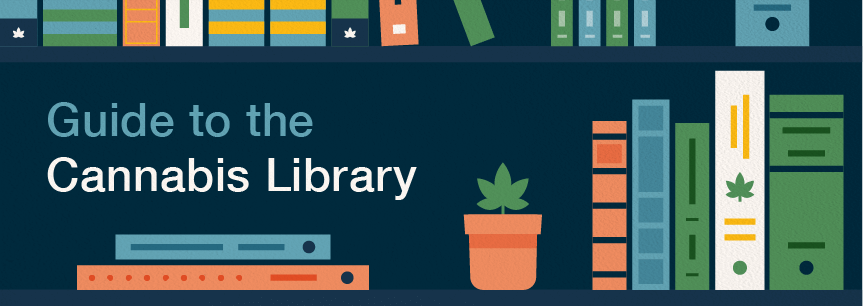
From tomes on botany, recipes and creative non-fiction to cultural musings and political history, there are over 5,200 printed books about cannabis — that’s enough to fill the shelves of a small library. And while new cannabis books are published each year, the best reads span decades. With authors including scientists, farmers, entrepreneurs, journalists, and outlaws, these books represent a rich portrait of America’s contrasting mores on cannabis.
With an ever-growing library, it’s especially challenging to decide which cannabis books to add to your list of must-reads. Not to mention the cannabis library is incredibly robust including genres like political history, horticulture, and entertainment. To aid in your decision-making process, we’ve rounded up 24 of the most intriguing, highly revered books and divided them into six sections to easily search.
As marijuana legalization changes the traditional perception of cannabis, education has never been more important. Scientific cannabis literature in the United States dates back to before the 1960s and is largely responsible for the legalization movement, as well as inspiration for modern scientific research. These books provide evidence-based scientific and medical literature on the many benefits of cannabis.
Author Dr. Lester Grinspoon didn’t set out to write a book that would change the world’s view of marijuana. In fact, when he started researching the controversial plant in 1967, he hoped to define cannabis as a dangerous drug and convince his best friend — famed astronomer Carl Sagan — to stop smoking marijuana.
But as the young Harvard Medical School associate professor dug deeper, he emerged with a new understanding of the plant and its medicinal potential — the title, “Marihuana Reconsidered,” reflected that change in view. This scholarly work highlights important scientific and medical facts about marijuana. Most importantly, its publication marked the first time in decades (since the LaGuardia Report) that literature outlined marijuana as a beneficial substance. Grinspoon’s book was a sensation that sparked a national debate, leading directly to our current era of rapid legalization.
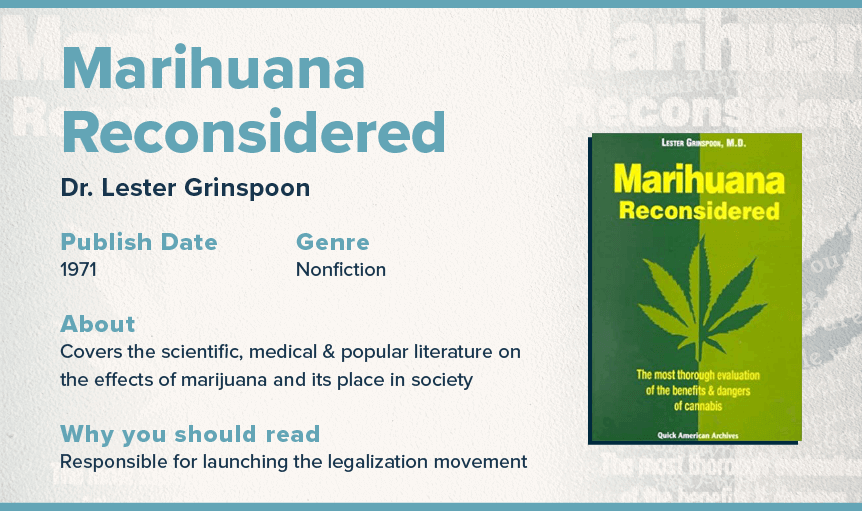
“The Pot Book” explores the notion that humans and cannabis co-evolved. It represents a broad spectrum of cannabis knowledge including cannabis culture, scientific research, the complex politics of cannabis law and its role in creativity, business and spirituality. The book also dives into the top 10 myths about marijuana, offering facts and authoritative opinions that debunk common misconceptions and stereotypes.
Author Julie Holland is an assistant clinical professor of psychiatry at the NYU School of Medicine. She’s considered a worldwide expert on street drugs and is quoted in Time, Harper’s, Slate and the Los Angeles Times.
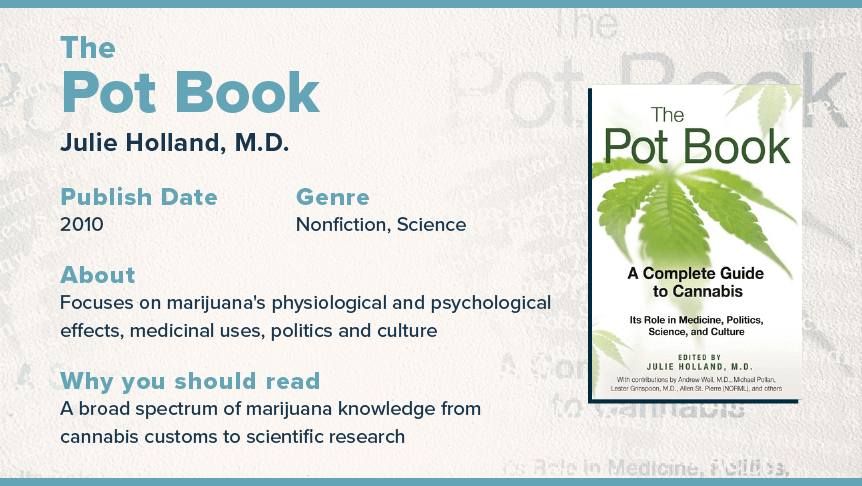
As the title suggests, “Marijuana Gateway to Health” chronicles the history of medical cannabis and compiles scientific studies about the plant’s efficacy. Author and researcher, Clint Werner, makes a powerful case that cannabis is not only effective at treating symptoms, but also preventing diseases while supporting underlying healing and wellness.
This book has a large focus on how cannabis works as a preventative agent in diseases like cancer and Alzheimer’s. It discusses the social perceptions and scientific data from a growing body of evidence while acknowledging that more research in this field is needed.
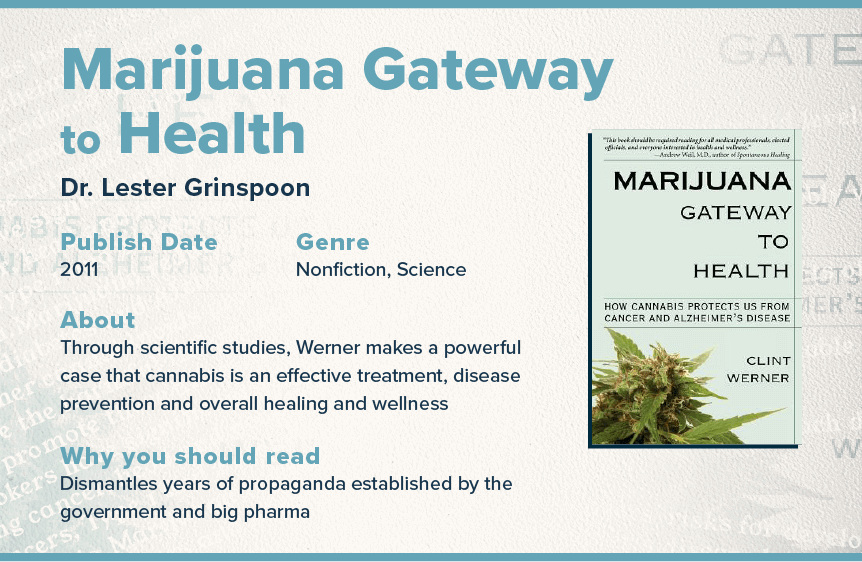
This easy-to-read book offers evidence-based information about using cannabis for a variety of ailments and conditions. Author Michael Backes outlines 29 ailments and illnesses that medical marijuana is commonly recommended for and provides readers with important information on varieties, how to identify them, delivery and dosage.
“Cannabis Pharmacy” is meticulously researched with a revised edition that’s up-to-date with the latest information on the body’s endocannabinoid system, which is understood to control emotion, appetite, memory and a host of bodily functions.
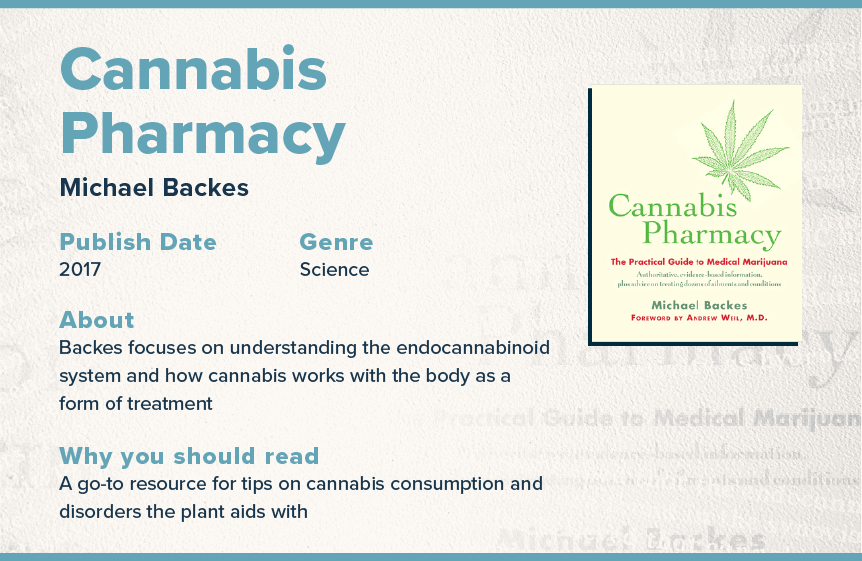
Much like same-sex marriage, feminism, health foods and The Rolling Stones, marijuana eventually won middle-class respectability. Yet America’s counterculture was once viewed as extremely threatening. “High in America” is the story of the prominent cannabis activist Keith Strop: a public interest lawyer who, with a lot of financial help from Playboy’s Hugh Hefner, founded the National Organization for the Reform of Marijuana Laws (NORML) in 1971.
The book is Strop’s colorful story — hanging out with Willie Nelson on his tour bus, enlisting Chip Carter’s support to convince his dad (president Jimmy Carter) to back decriminalization, lobbying Congressmen, railing against U.S. funding of the Mexican government to spray a toxic pesticide on marijuana fields, and building one of the largest grassroots organizations in the world.
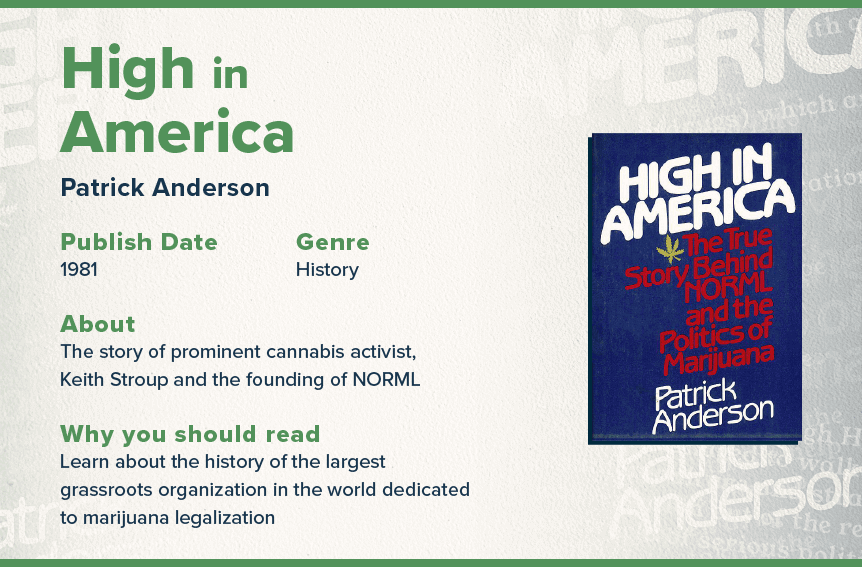
When infamous cannabis activist Jack Herer was given two weeks in prison for trespassing on federal property to collect signatures for a cannabis ballot initiative, he used the time to begin writing “The Emperor Wears No Clothes.” The title, referring to Hans Christian Anderson’s classic children’s tale “The Emperor’s New Clothes,” was used as an allegory for the failures and illogic of cannabis prohibition.
Published in 1985, the book immediately lit a fire under the marijuana and hemp legalization movements, which had been floundering in Reagan’s America. The book details vast historical data on the environmental benefits of cannabis that continue to be cited in cannabis legalization efforts today.
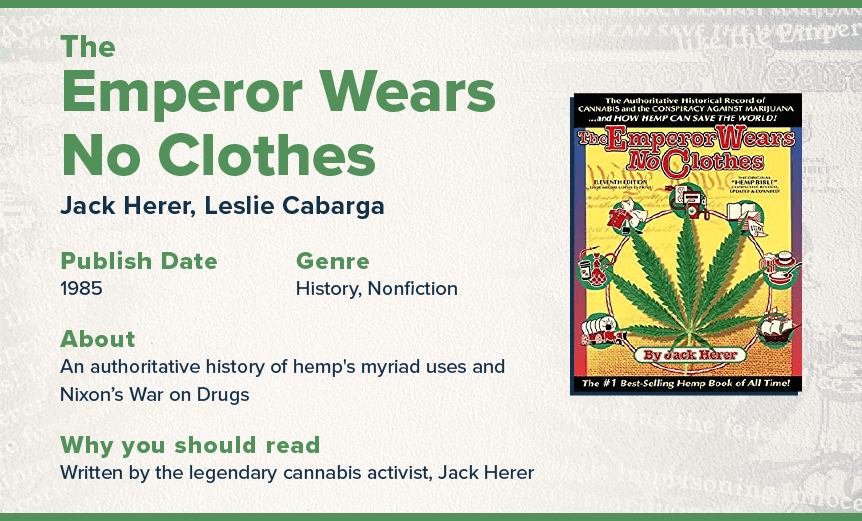
“Smoke Signals” brings an incredible depth of knowledge and a spotlight to the heroism and hypocrisy of cannabis in America. It tells the story of a community that fought against an oppressive system to ultimately win the day. This historical read shows not just what happened that made cannabis illegal, but how and why it happened.
Author Martin Lee examines the 19th century as an era of great personal freedom with respect to psychoactive substances and how drastically this changed just a century later. He details how misguided and cruel the authorities were in carrying out the herbal vendetta that was and is the War on Drugs.
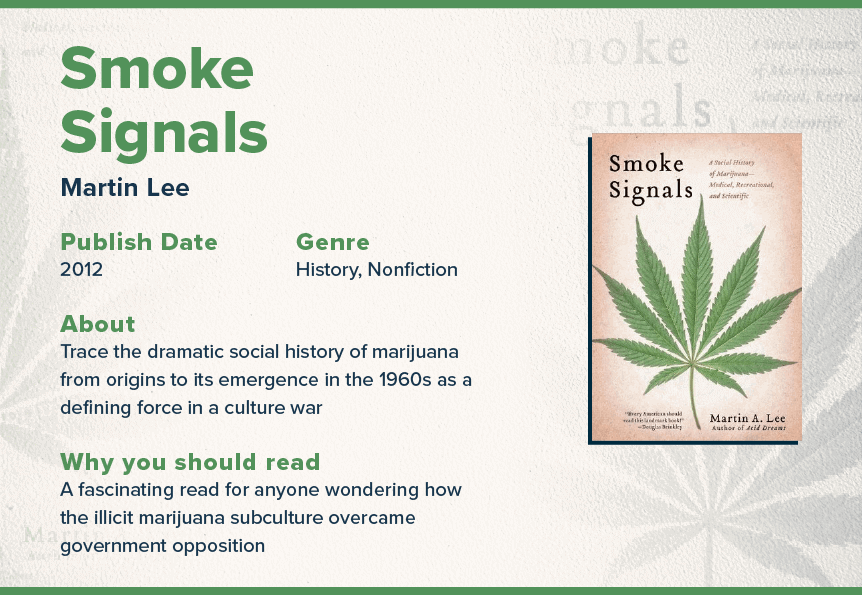
Steve DeAngelo, a leader in the movement to reform marijuana laws, wrote what many equate to the Declaration of Independence for cannabis. His book is both a call to action and a radical vision of humans’ relationship with this healing but controversial plant. He stated: “I believe there is no such thing as the recreational use of cannabis. The concept is equally embraced by prohibitionists and self-professed stoners, but it is self-limiting and profoundly unhealthy. Defining cannabis consumption as elective recreation ignores fundamental human biology and history, and devalues the very real benefits the plant provides.”
“The Cannabis Manifesto” answers essential questions about the plant — citing extensive research — and fuels a thoughtful discussion about cannabis science and law, in addition to its biological, mental and spiritual effects.
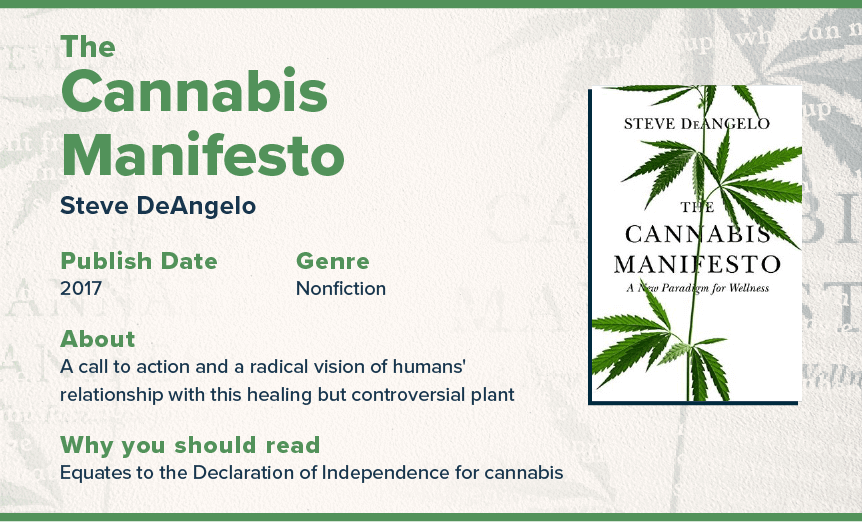
Whether you’re an advocate for cannabis or just a history buff, these books are key to understanding the societal role of cannabis and the events that have made it a controversial substance.
This historical text by Ernest Abel uses research to take you on an adventure, beginning with the earliest knowledge of cannabis on the island of Taiwan during the Stone Age. It follows the plant’s footprints through Asia, Africa, Europe, and the Americas.
Marijuana is, without a doubt, an herb that has been many things to many people and this book highlights exactly that — including its complex role in witchcraft, medicine, drug abuse, literature and social perception. As you might suspect, this title delivers what it promises: an extensive look at the early history of marijuana.
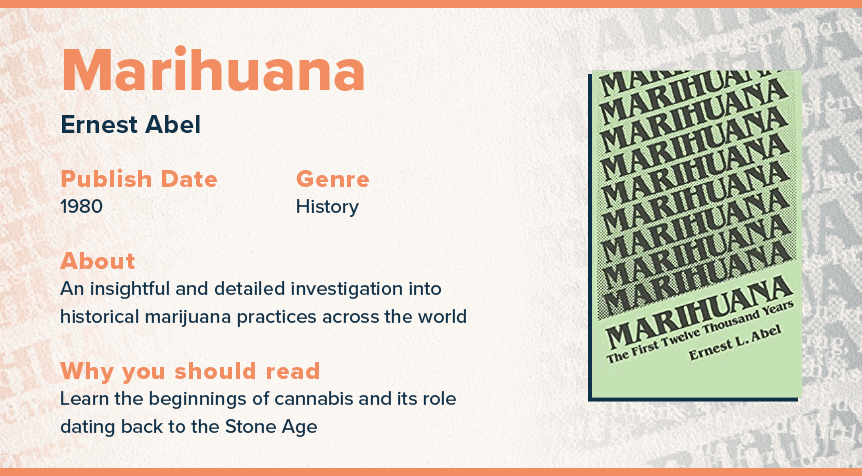
Not that long ago, it was seriously believed by white Americans that the African American population was conspiring with the Chinese in order to rape and enslave white girls seduced with marijuana — the unholy trinity of sex, drugs, and violence. Today it sounds absurd, but the late 1930s were largely defined by ignorance and hysteria, a period most commonly known as the “Reefer Madness” era.
“Reefer Madness” is a classic in the annals of cannabis literature that details the popular social history of marijuana use in America, starting with George Washington as a hemp farmer and working through the decades. Read it to learn the fascinating story of our nation’s love-hate relationship with the resilient weed we know as marijuana.
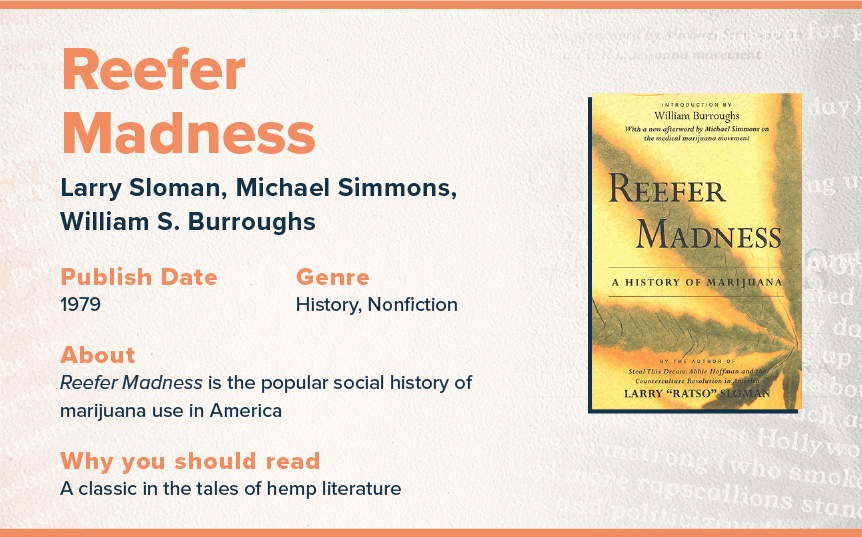
In this comprehensive text, author Martin Booth covers all the bases of cannabis history, including the stories of medical advancement and religious enlightenment; political deceit and abuse of power; and cannabis smugglers, dealers, writers, artists and musicians.
Above all, Booth explains how sheer ignorance has produced some of the most grotesque legislation over the years, how cannabis became outlawed in the Western world and the impacts cannabis illegality has on the global economy.
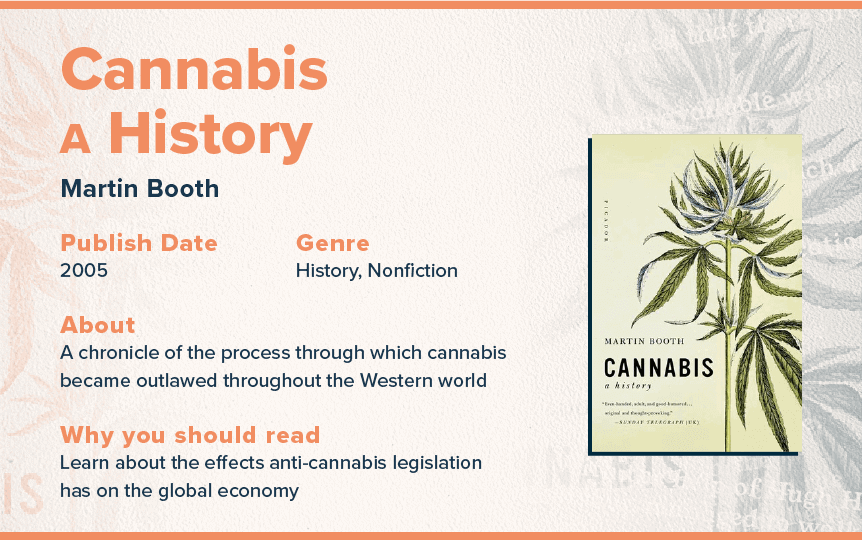
It’s one thing to believe in something, but it’s another to fight for it. “Grass Roots” is the story about how earnest hippies, frightened parents, suffering patients and ordinary Americans went to war over marijuana. The book compares today’s legalization progress to a similar trajectory years ago and how a drastic shift in perceptions resulted in a fierce backlash.
In “Grass Roots,” author and historian Emily Dufton tells the remarkable story of marijuana’s crooked path from acceptance to demonization and back again. Most importantly, it’s also about the thousands of grassroots activists who made changing marijuana laws their life’s work.
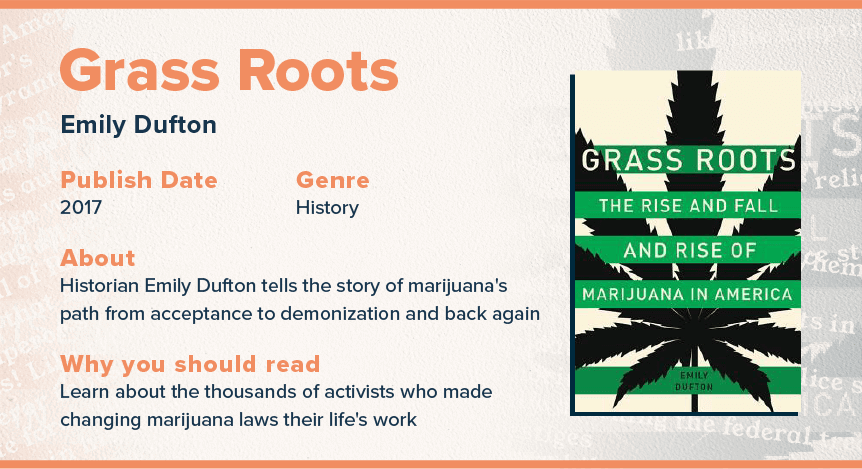
From heady philosophy and escapist thrillers to personal accounts of the counterculture era, there’s no shortage of intellectual reads that are best cracked open when high. These staple books are great ways to get the wheels turning and get lost in the pages. We suggest you plant yourself somewhere comfy since these books are notorious for hooking readers.
This quintessential book of the 70s spawned from a combination of two magazine assignments: one from Rolling Stone and the other from Sports Illustrated. The story follows its protagonist, Raoul Duke, and his attorney, Dr. Gonzo, from Los Angeles to Las Vegas on assignment as their work intentions turn to drugs, alcohol and gambling when they descend upon a 70s version of Sin City.
“Fear and Loathing in Las Vegas” is an American pop culture classic. Dig into the comedic side of the book through the pair’s hilarious ramblings and iconic quotes. You’ll likely recognize some of them from the iconic film adaptation featuring Johnny Depp and Benicio Del Toro.
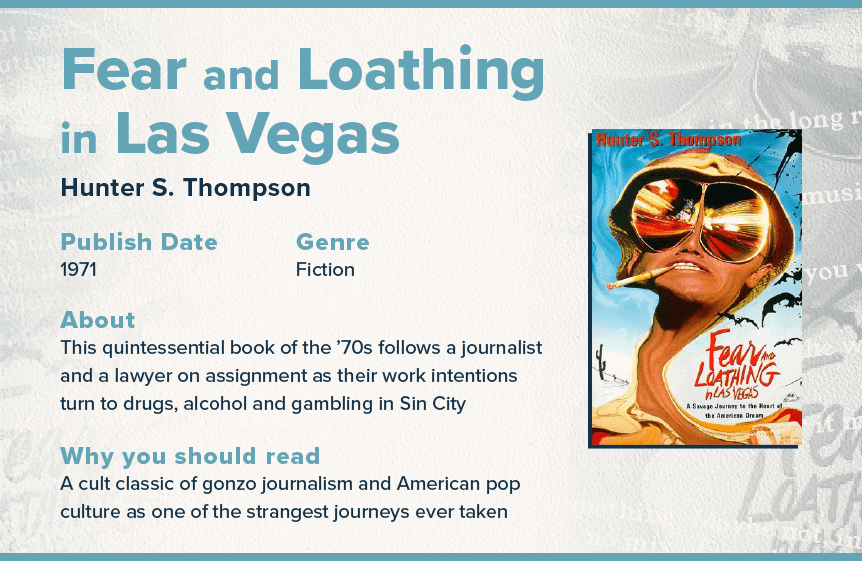
After becoming famous for his book “On the Road,” Jack Kerouac wrote “The Dharma Bums” to escape the popular attention he received from the media at the time, and the plot details just that. “The Dharma Bums” is the story of two men engaged in a passionate search for truth and zen through marathon wine-drinking bouts, poetry jam sessions, marijuana in San Francisco’s Bohemia and solitude in the high Sierras.
This read offers up great life lessons in a story that captures a zest for life and the quest for inner peace and freedom that many seek.
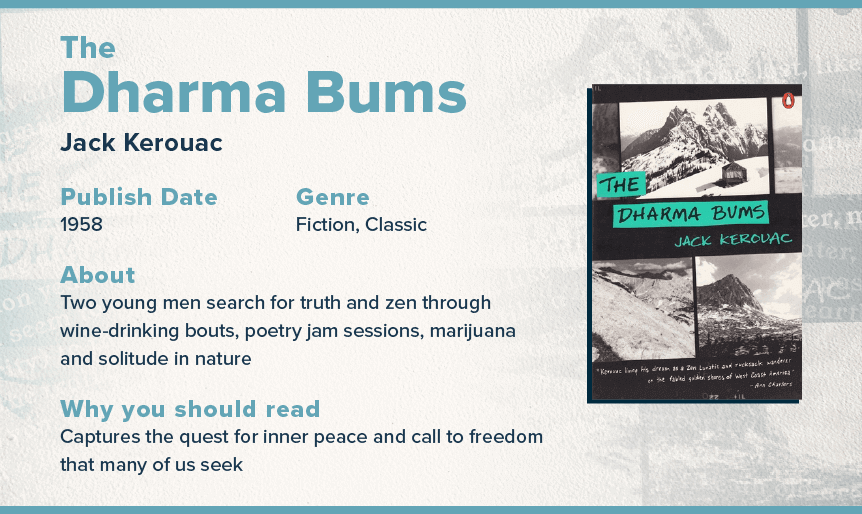
There are many stories that portray how travel and cannabis often go hand-in-hand, and Alex Garland’s “The Beach” is proof of that connection. The plot surrounds an English traveler named Richard who sets off to find a secret beach paradise in Thailand. In addition to finding an idyllic secluded island, he stumbles upon a cannabis plantation and a whole lot of weird.
“The Beach” captures the late 90s zeitgeist and urge to fight boredom by setting off on thrilling backpacking adventures to countries like Thailand, Vietnam and Cambodia. Garland’s book is a suitable 4/20 read, pairing dark tones with scenes of relaxation, celebration and, of course, the presence of marijuana.
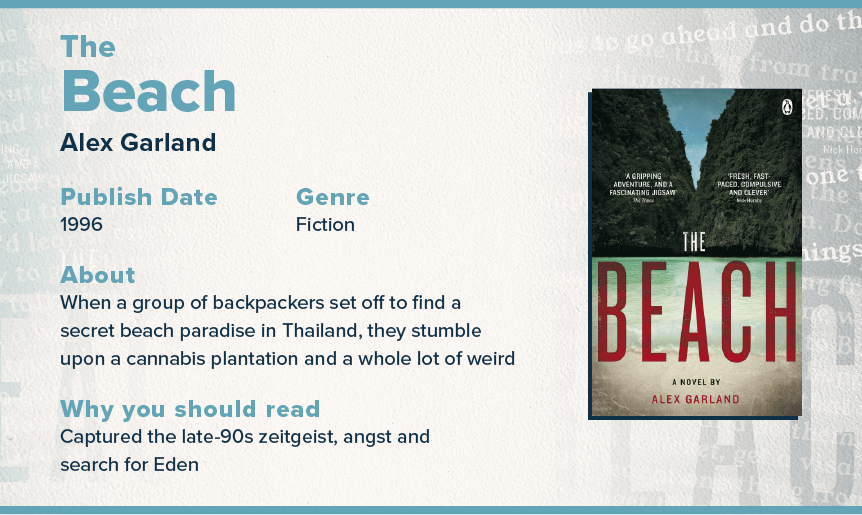
Michael Chabon’s novel is an homage to the real Telegraph Avenue, a street that stretches from downtown Oakland all the way to Berkeley. “Telegraph Avenue” paints a picture of diversity along a street where college students roam with $7 coffees in hand: artists set up shop, medical marijuana shops are ever-growing and the homeless look for a place to rest.
The book concerns the fate of a used record shop about to be swallowed up by a mega-entertainment store, among other topics like paternal failings, maternity wards, filial duty, and blaxploitation. But the underlying message is about the inevitability of change, surrendering to it and the possibility of finding grace on the other side.
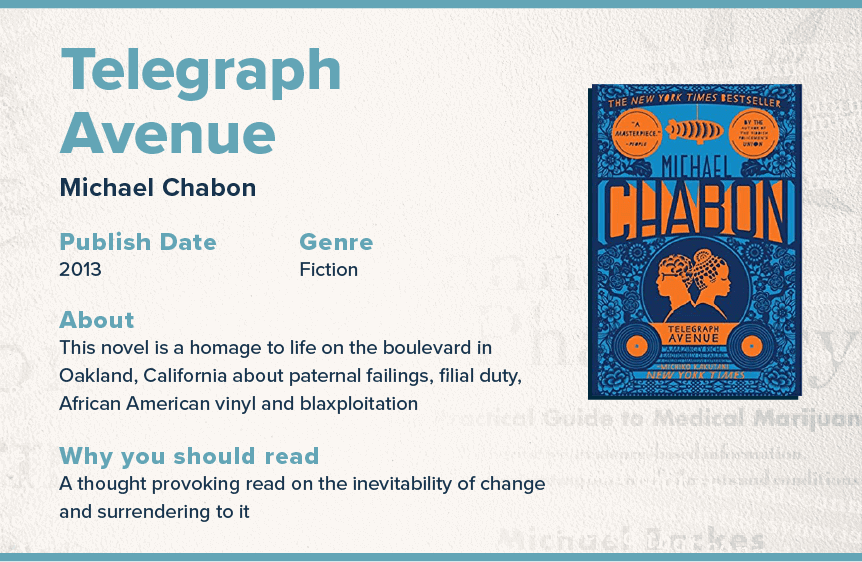
Cannabis and cooking go hand-in-hand, but for years, edible weed eats have lacked ingenuity. All that is changing in today’s modern cannabis era. Read below for the best cannabis cookbooks that go beyond brownies and stoner college food.
Take cannabis recipes from basic to gourmet. This game-changing book expanded the idea of cannabis cuisine “beyond the brownie” at a time when many chefs still scoffed at the idea. This cookbook is an intelligent read with excellent information about food, cannabis and — of course — how to cook with it. It also dives into the different ways cannabis has influenced culture and food by including some of the oldest cannabis recipes like hash brownies or bhang.
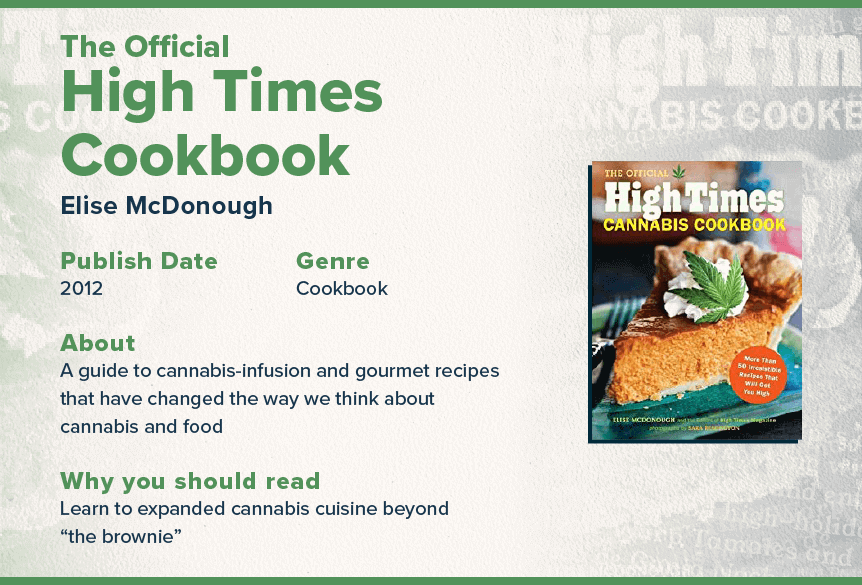
Vegan cooking has a tendency to be difficult for many people, but it doesn’t have to be! This irreverent take on veganism simplifies the cooking process by providing yummy, filling meals that require minimal ingredients, time and effort. Authors Sarah Conrique and Graham Haynes offer up foolproof recipes for breakfast, lunch and dinner — including some delicious (and healthy) munchie recipes like mean green smoothies, bahnwiches, animal cookies, churro chips and more.
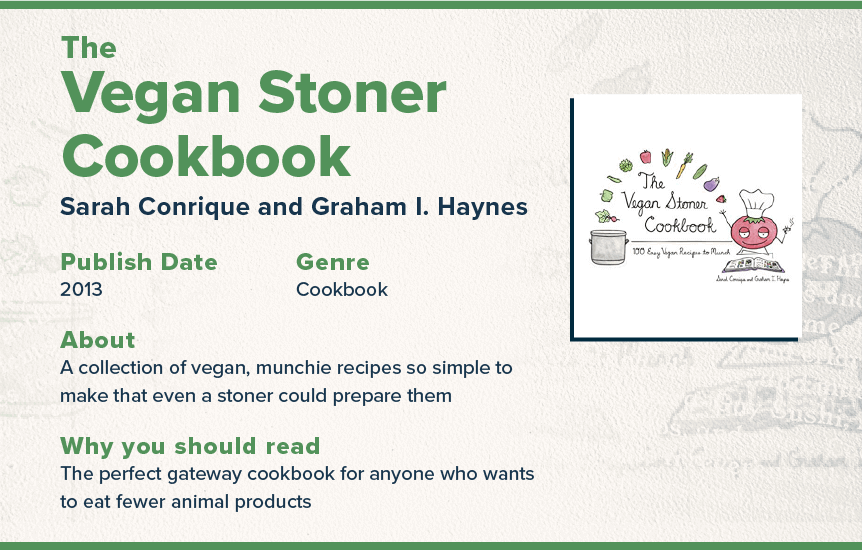
One of the newest cannabis cookbooks to hit the shelves is “Bong Appétit” — what many consider to be the “Joy of Cooking” for a new generation interested in making serious, sophisticated food with weed.
This cookbook is especially helpful in breaking down the science of infusing (oils, butters, milks, alcohol and more) with cannabis. Recipes range from weed butter-basted chicken and weed chimichurri to weed brownie sundaes. Especially noteworthy are the tips on how to check the quality of your weed, suggestions on what to ask at the dispensary and an important section on understanding the effects and proper dosages of THC.
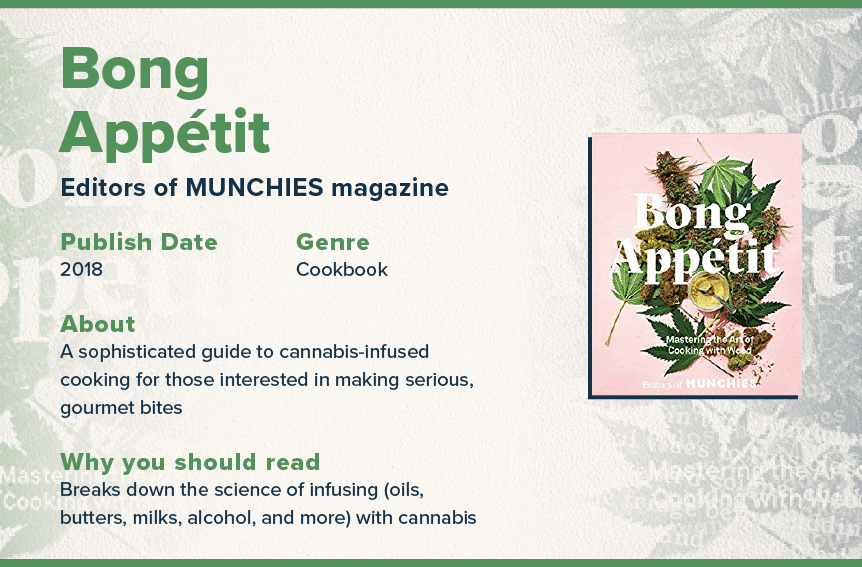
“Edibles” is the perfect book for the first time cannabis chef. This user-friendly cookbook is notable in a few ways: There is a lengthy introductory section that discusses dosage, potency, effects, terminology and techniques, including 30 recipes that are purposefully low-dose treats.
Recipes go beyond typical “college food.” Instead, offering up well-written recipes like cardamom caramels, gruyère and green garlic gougères, strawberry jam Pavlovas, and roasted grape crostini. If you’re not drooling already, the blueberry lemon French macarons will do the trick!
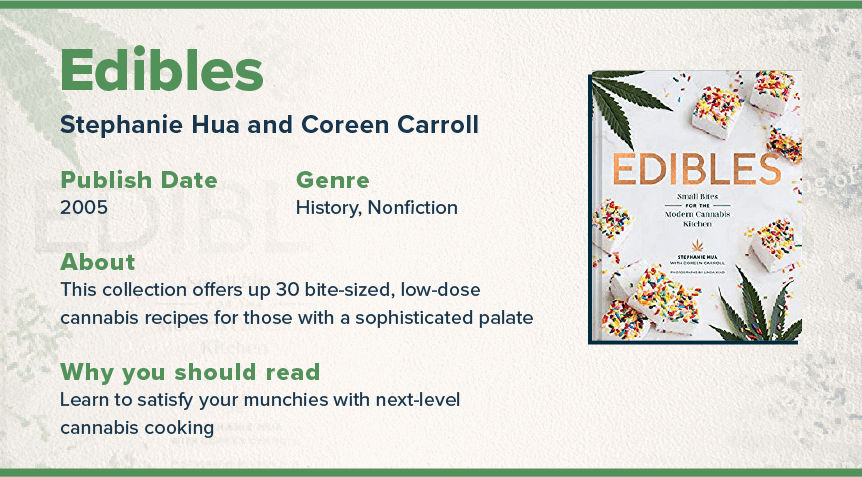
When it comes to growing cannabis, knowledge is power. These reads are world-renowned if you’re looking to channel your inner green thumb.
Jorge Cervantes, also known as George Van Patten, offers up a plethora of information and detailed instructions to hobbyists and professional growers in his book “Marijuana Horticulture.” Considered the ultimate guide to all forms of marijuana growing, this book provides tips and details from Van Patten’s many years as an underground grower in Mexico and California in addition to contributions from 300 experts in the field.
While “Marijuana Horticulture” focuses on all kinds of cannabis growing, it’s especially helpful for those interested in cultivating in a backyard, a basement or on a small plot.
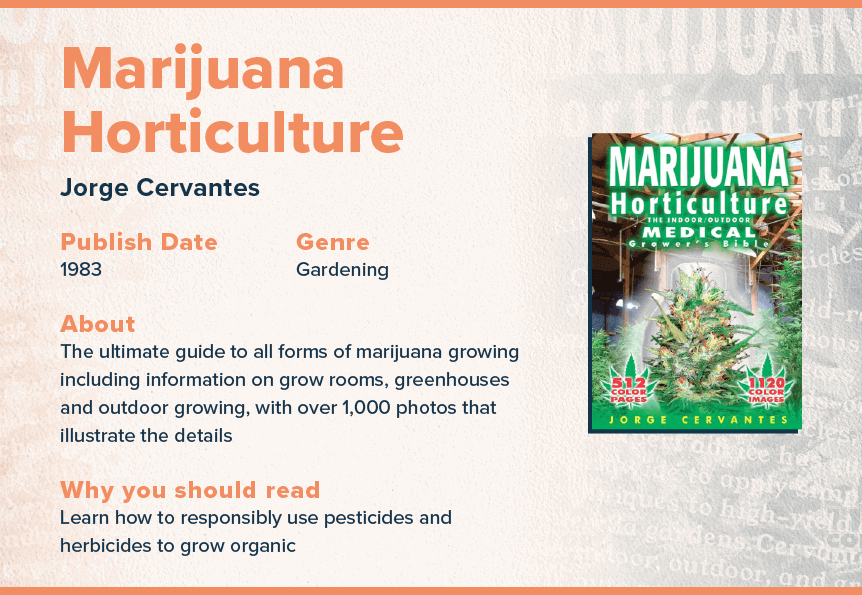
Author and legendary grower Ed Rosenthal shares his knowledge and experience on every portion of the life cycle of the cannabis plant. Readers can gather tips from seed selection to harvesting. The handbook is a great read for new indoor growers, including information on light, temperature, nutrients, water, sexing plants and more.
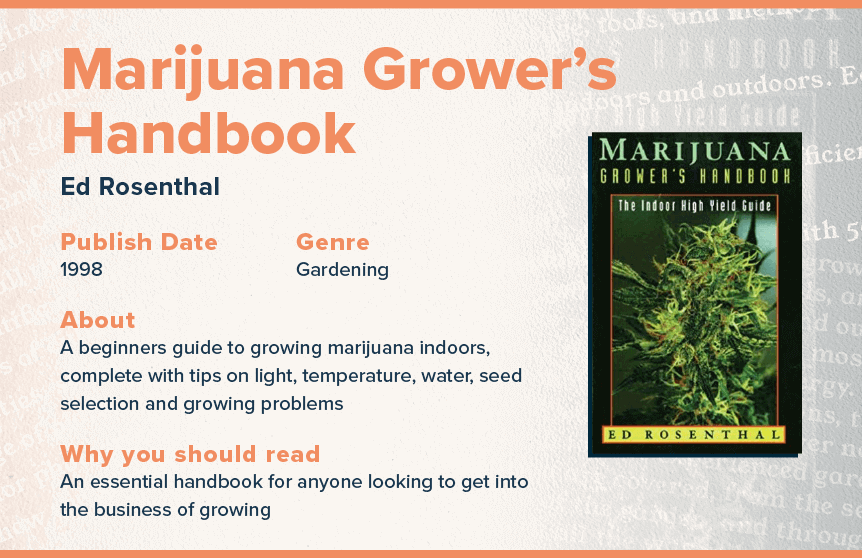
“The Cannabis Grow Bible” is exactly that — your handbook to growing. This resource dives into the art and science behind growing high-grade cannabis and offers helpful methods that maximize both yield and potency.
For visual learners, the book is Illustrated in full color with techniques for both indoor and outdoor cultivation. This comprehensive guide covers everything growers need to know, including how to select the best plant genetics, soil versus hydroponic grows, how to deal with pests, advanced systems, breeding and protecting your crop from nosy neighbors.
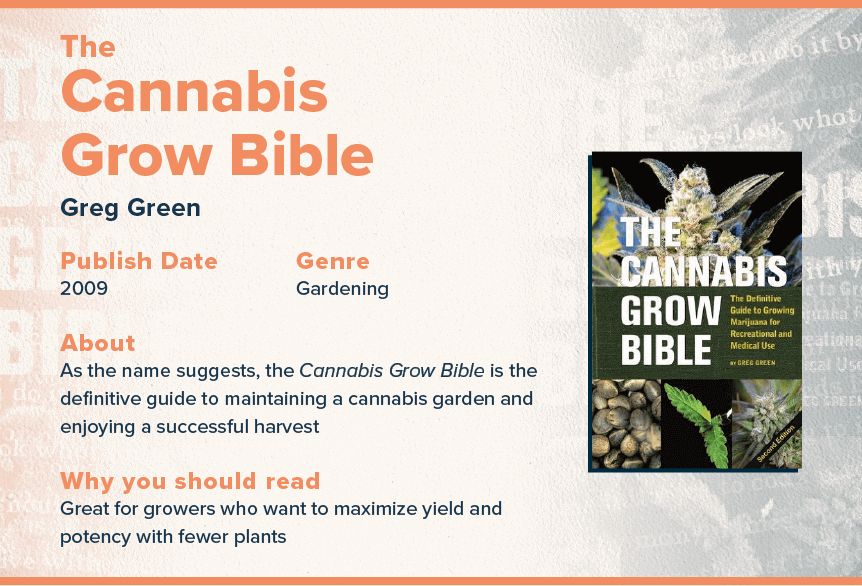
“True Living Organics” is a mindful exploration of an alternative to growing. Considered the only organic growing guide, this book shows how to change an existing grow room into an all-natural, synthetic-free, living, breathing cannabis cultivation space.
This book is based on the concept that plants evolved for millions of years to function best in their natural environments, so the tips transfer across any crop, whether it’s cannabis or tomatoes. “True Living Organics” is written in an accessible, easy-to-follow style that sifts through the jargon surrounding organic marijuana growing and gets straight to the heart of the matter: the living soil.
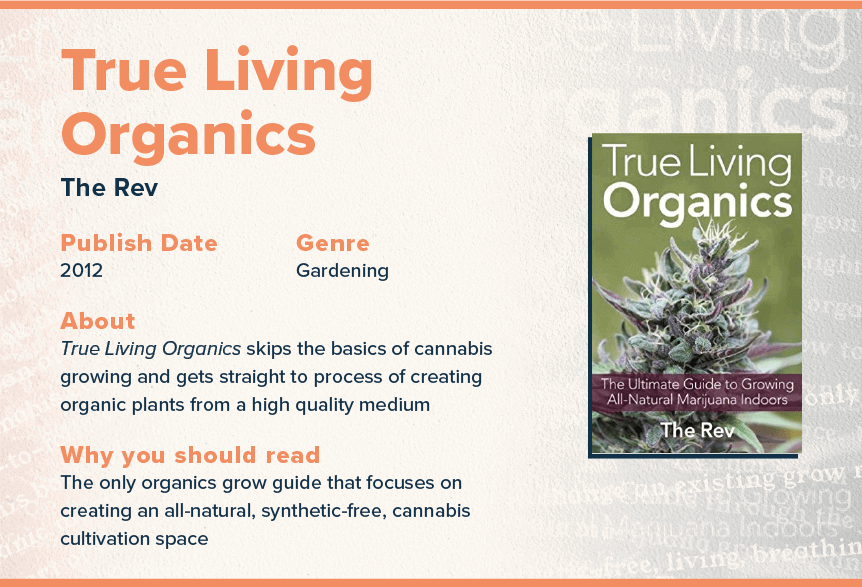
They say knowledge is power, and this is especially true when it comes to cannabis. From cookbooks and horticulture to historical and cultural reads, these books have been and continue to be monumental in challenging politics, scientific research, cultural norms and reshaping the way we think about cannabis as a society. While many of these books have been a driving force in the legalization movement, it’s especially important to recognize the authors that published evidence-based scientific research that paved the way for medical marijuana access.
No Information on MarijuanaDoctors.Com should be used to diagnose, treat, prevent or cure any disease or condition. You can view our Full Disclaimer here.